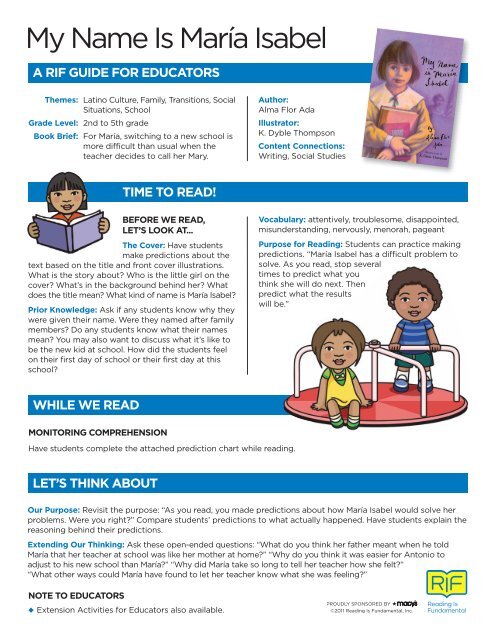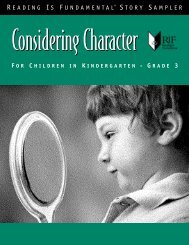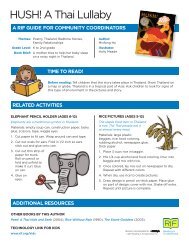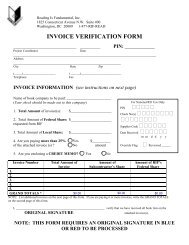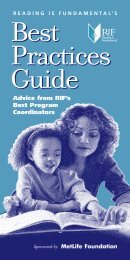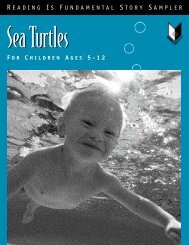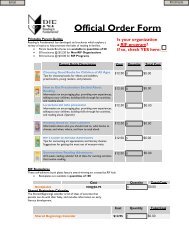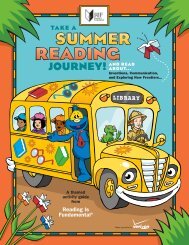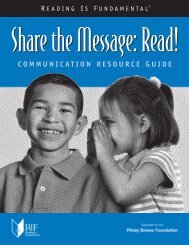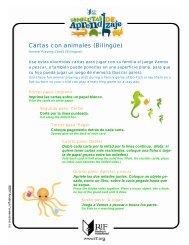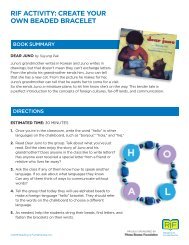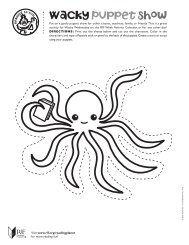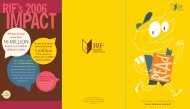My Name is Maria Isabel
My Name is Maria Isabel
My Name is Maria Isabel
Create successful ePaper yourself
Turn your PDF publications into a flip-book with our unique Google optimized e-Paper software.
<strong>My</strong> <strong>Name</strong> Is María <strong>Isabel</strong>A RIF GUIDE FOR EDUCATORSThemes: Latino Culture, Family, Transitions, SocialSituations, SchoolGrade Level: 2nd to 5th gradeBook Brief: For María, switching to a new school <strong>is</strong>more difficult than usual when theteacher decides to call her Mary.Author:Alma Flor AdaIllustrator:K. Dyble ThompsonContent Connections:Writing, Social StudiesTIME TO READ!BEFORE WE READ,LET’S LOOK AT...The Cover: Have studentsmake predictions about thetext based on the title and front cover illustrations.What <strong>is</strong> the story about? Who <strong>is</strong> the little girl on thecover? What’s in the background behind her? Whatdoes the title mean? What kind of name <strong>is</strong> María <strong>Isabel</strong>?Prior Knowledge: Ask if any students know why theywere given their name. Were they named after familymembers? Do any students know what their namesmean? You may also want to d<strong>is</strong>cuss what it’s like tobe the new kid at school. How did the students feelon their first day of school or their first day at th<strong>is</strong>school?Vocabulary: attentively, troublesome, d<strong>is</strong>appointed,m<strong>is</strong>understanding, nervously, menorah, pageantPurpose for Reading: Students can practice makingpredictions. “María <strong>Isabel</strong> has a difficult problem tosolve. As you read, stop severaltimes to predict what youthink she will do next. Thenpredict what the resultswill be.”WHILE WE READMONITORING COMPREHENSIONHave students complete the attached prediction chart while reading.LET’S THINK ABOUTOur Purpose: Rev<strong>is</strong>it the purpose: “As you read, you made predictions about how María <strong>Isabel</strong> would solve herproblems. Were you right?” Compare students’ predictions to what actually happened. Have students explain thereasoning behind their predictions.Extending Our Thinking: Ask these open-ended questions: “What do you think her father meant when he toldMaría that her teacher at school was like her mother at home?” “Why do you think it was easier for Antonio toadjust to h<strong>is</strong> new school than María?” “Why did María take so long to tell her teacher how she felt?”“What other ways could María have found to let her teacher know what she was feeling?”NOTE TO EDUCATORS◆ Extension Activities for Educators also available.
ProblemPREDICTION CHART<strong>My</strong> PredictionWhat Really Happened
<strong>My</strong> <strong>Name</strong> Is María <strong>Isabel</strong>A RIF GUIDE FOR PARENTS AND FAMILIESThemes: Latino Culture, Family, Transitions, SocialSituations, SchoolGrade Level: 2nd to 5th gradeBook Brief: For María, switching to a new school <strong>is</strong>more difficult than usual when theteacher decides to call her Mary.Author:Alma Flor AdaIllustrator:K. Dyble ThompsonTIME TO READ!Before reading, makeconnections: Has your familyever moved? How did yourchild feel as the new kid atschool? Was it hard to fit in?While reading, look at thepictures: There aren’t many pictures in th<strong>is</strong> book, sothe few pictures there are must be really important.What scenes from the book do the pictures show?Why do you think the art<strong>is</strong>t chose those scenes?After reading, ask questions:◆ Why did María’s teacher call her Mary?◆ Why do you think her teacher calling her Marybothered María so much?◆ What would you have done if you were in María’ssituation?◆ Is your name important to you? Why or why not?RELATED ACTIVITIESWHAT’S IN A NAME?Materials: camera or camera phone, sc<strong>is</strong>sors, tape, paperTake pictures of letters around town (in signs, onbillboards, etc.). You can also take some pictures ofyour favorite places. Print or develop the picturesand make a collage of your name. If you don’t have aprinter, use a free website like www.smilebox.com tomake an online scrapbook of your pictures.OUT AND ABOUTTalk with your child about the importance of theirname. What does it mean? How did you come upwith it? Are they named after a relative or a closefamily friend? Did you almost name your childsomething else? Share stories about your own nameor the names of other family members.RED BEANS AND RICEIngredients: 1 cup cooked rice, 1 can red beans(drained), olive oil, 1/4 cup chopped green or redpepper, chopped onion, 1 garlic clove, 1/4 tsp.coriander, pepper to tasteCook peppers and onions in a pan with a little oliveoil. When softened, add finely chopped garlic clove.Cook for another minute. Add red beans, 2 tbsp.water, coriander andpepper. Cover andsimmer for 30minutes. Add beansto cooked rice. Mixand eat.ADDITIONAL RESOURCESOTHER BOOKS BY THIS AUTHORI Love Saturdays y domingos (2004), Dancing Home(2011), Yours Truly, Goldilocks (2001), With Love, LittleRed Hen (2004), The Lizard and the Sun (1999).
<strong>My</strong> <strong>Name</strong> Is María <strong>Isabel</strong>A RIF GUIDE FOR COMMUNITY COORDINATORSThemes: Latino Culture, Family, Transitions, SocialSituations, SchoolGrade Level: 2nd to 5th gradeBook Brief: For María, switching to a new school <strong>is</strong>more difficult than usual when theteacher decides to call her Mary.Author:Alma Flor AdaIllustrator:K. Dyble ThompsonTIME TO READ!Before reading: D<strong>is</strong>cuss the importance of names. The little girl in the story <strong>is</strong> proud of hername because she was named after relatives. Find out if your kids know who they werenamed after and why, or what their names mean. Are their names important to them?RELATED ACTIVITIESTISSUE PAPER FLOWERS (AGES 5-12)Alma Flor, the author’s name, means “soul flower”in Span<strong>is</strong>h. Make t<strong>is</strong>sue paper flowers in honor of theauthor!Materials: t<strong>is</strong>sue paper, yarn, tape, sc<strong>is</strong>sors1. Stack six sheets of t<strong>is</strong>sue paper. They can bedifferent colors or all the same color. Fold thestack like a fan/accordion.2. Cut folded paper fan in half through the middle.Each half will make one flower.3. Take one half (still folded) and trim both ends intoa rounded point.4. Tie yarn around the center of each folded fan ofpaper.5. Gently separate each layer of the folded paper bypulling up and down until you have a circular shape.6. Tape ends together at the top and bottom so theflower will stay open.THE NAME GAME (AGES 7-12)Materials: paper, pencils, crayons or markersHave the children write acrostic poems using theirnames. For each letter of their name, they shouldthink of a word or phrase that describes them.They should decorate their poemswith pictures ofthemselves ortheir favoritethings.Example:ADDITIONAL RESOURCESOTHER BOOKS BY THIS AUTHORI Love Saturdays y domingos (2004), Dancing Home (2011), Yours Truly, Goldilocks(2001), With Love, Little Red Hen (2004), The Lizard and the Sun (1999).TECHNOLOGY LINK FOR KIDSwww.rif.org/kids


